Based on a Forrester survey from 2019, unplanned downtime costs 35% more per minute than planned downtime.
From natural disasters to cyberattacks, the challenges are real, and the consequences are severe.
Companies are often unprepared for unplanned downtime, and their slow reaction causes a dramatic loss of productivity and money.
How can they prevent this?
This article unveils the answer: A business continuity plan (BCP) is a strategic shield against unforeseen adversities, helping companies withstand, adapt, and emerge stronger from disruptive challenges.
Key takeaways
- A well-crafted BCP empowers organizations to quickly recover and continue operations. It provides relevant recovery strategies and techniques to secure the survival and success of businesses.
- Whether you operate in fintech, healthcare, cloud services, or any other industry, a BCP is an essential tool for maintaining operations during unforeseen circumstances.
- Testing your continuity strategies offers an opportunity to fine-tune the BCP and address any issues that might only become apparent once the plan is put into practice.
What is a business continuity plan (BCP)?
A business continuity plan is a survival tool tailored to each organization’s natural course of operation.
This document merges comprehensive techniques in risk assessment and crisis management.
Companies employ BCPs to anticipate potential threats like pandemics, human error, and technological failures.

Not just recovery but prevention
A robust business continuity plan goes beyond the recovery process.
A BCP helps you foster a culture of preparedness within your organization.
While recovery focuses on responding after an event, preparedness plans for and mitigates risks before they escalate into crises.
For instance, hospitals must have backup generators and detailed protocols to ensure continuous patient treatment, even in blackout scenarios.
For online services, maintaining alternative server backup systems ensures seamless transactions and customer service even during unexpected system crashes.
This proactive approach ensures your team can either maintain or swiftly restore essential business functions during unexpected events.
What does a business continuity plan typically include?
Here’s a concise breakdown of the components you can expect to find within a robust BCP.
- Initial data and emergency contacts provide immediate access to critical contacts, ensuring swift communication during an incident.
- Revision management outlines how the plan is maintained and updated over time, ensuring its effectiveness.
- Purpose and scope define the plan’s objectives and what business areas it covers.
- Activation guidelines explain when and how to activate the BCP, ensuring a clear understanding of the plan’s implementation.
- Policy information incorporates organizational policies that directly impact business continuity and recovery efforts.
- Emergency response procedures detail the actions to be taken in the event of a disruption, ensuring an organized response.
- Scenario-specific procedures provide specific instructions for various scenarios, such as natural disasters, cyberattacks, or public health crises.
- Checklists and flow diagrams simplify complex processes and guide users through critical tasks.
- A glossary of terms defines technical or industry-specific terminology for clarity.
- Review and update schedule outlines regular assessments and revisions to maintain the plan’s relevance and effectiveness.
7 key steps to create a solid business continuity plan
Follow these actionable steps to create and implement a tailor-made BCP for your unique circumstances.
Step 1: Dive into the unknown to initiate risk assessment and business impact analysis (BIA)
Assess how much revenue could be lost during a specific disruption period.
In practice, this also involves analyzing historical data on incidents like natural disasters, cyberattacks, or supply chain disruptions.
A business impact analysis (BIA) helps you understand how those risks can specifically affect different areas of your business.
For instance, a local hospital identified a power outage as a potential risk.
A BIA helps them understand when and how many patients in the intensive care units could die if power goes down.
That’s where the emergency generators are supposed to kick in.
Answer these foundational business continuity questions to forge a robust BCP.
- Who’s in the line of fire? Who will be directly impacted by a business disruption, from customers and employees to suppliers and stakeholders?
- Who safeguards critical emergency contact information for top clients? Where’s your data center? Who holds a hard copy?
- When and how will you alert everyone?
- If phone lines go silent, what’s the backup plan? What are your alternative communication options?
- What risk management team members do you need for a swift recovery? How do you reach or relocate them when it matters most?
- What should be your first focus when restoring operations?
- What issues must be addressed within the first 24 to 48 hours?
- Does each team and department have their own BCP? Who’s the commander of each unit?
- For senior staff members, including the CEO, what’s the emergency succession plan?
- Which team members will step into emergency roles?
- Where will you convene when it’s time to strategize off-site?
- Who liaises with local emergency responders, from firefighters to police?
- Who are the key vendors, especially data backup providers?
Clearly state the objectives of the BIA to your employees that the knowledge acquired will help you allocate resources for effective continuity planning
Step 2: Stack rank your critical business functions
Assign a level of importance to the following departments or business processes:
- Customer service (ensuring client satisfaction)
- Order processing (critical for revenue)
- Supply chain management (maintaining product availability)
- Financial transactions (essential for cash flow)
- Regulatory compliance (to prevent legal issues)
- Backup equipment like desktops, laptops, and servers (to exclude workflow gaps)
Your critical business functions must remain uninterrupted.
You’ll want to ensure that your document management and security are robust during the continuity planning process.
For instance, document repository solutions allow you to keep all your documents in one place, making it easier to access critical documents when needed.
Moreover, these platforms provide enterprise-grade security, which is E-SIGN, UETA, and HIPAA compliant and backed by SOC 2 certification, offering the utmost confidence when dealing with sensitive data.
Step 3: Domain-specific cheat sheet: Key functions & strategies to keep them operational
- Review process documents and SOPs to understand departmental collaboration.
- Organize cross-functional brainstorming for diverse insights.
- Consult industry experts for broader, industry-specific continuity strategies.
| Domain | Key functions to prioritize | Strategies for maintaining critical functions |
|---|---|---|
| Energy suppliers | Power generation | Diversify power sources (renewable, gas, fossil fuels) to reduce reliance on one grid. |
| E-Commerce sector | Inventory & delivery | Establish backup inventory sources and alternative delivery routes for seamless service. |
| Customer service | Remote support | Utilize cloud-based systems and digital communication platforms for remote customer support. |
| Supply chain management | Supplier diversification | Diversify the supplier base to ensure an uninterrupted flow of goods and materials. |
| Healthcare facilities | Telemedicine infrastructure | Invest in telemedicine infrastructure for virtual patient consultations and maintain redundant life-saving equipment. |
| Banks & financial organizations | Secure, cloud-based systems | Deploy secure, cloud-based banking systems for remote operations and engage cybersecurity firms for 24/7 monitoring. |
| Manufacturing companies | JIT inventory & diversified suppliers | Implement just-in-time (JIT) inventory strategies and maintain contracts with multiple suppliers for critical components. |
| Schools & universities | E-Learning platforms & hotspots | Develop comprehensive e-learning platforms with live streaming, online assignments, and digital libraries. Set up hotspots for underprivileged students. |
| Retail businesses | E-Commerce integration & inventory control | Maintain integrated e-commerce websites with mobile apps, offer multiple payment options, and ensure efficient last-mile delivery services. |
Step 4: When every second counts — define tolerable delays for vital functions
Keeping all your critical functions running during a disruptive event isn’t always feasible.
That’s why you must define the maximum allowable downtime for these functions in your business continuity planning.
Engage with your stakeholders to understand their tolerance for disruptions and align your recovery time objectives (RTOs).
BCP industry-specific benchmarks and standards can provide valuable insights into what is considered an acceptable downtime within your sector.
Step 5: Marvel is not the sole hero to assemble Avengers — build your unstoppable continuity team
You can’t fight disasters alone.
Let’s zoom in on the key players that should always make up your continuity team.
- IT professionals’ expertise ensures the safety and accessibility of your sensitive data and systems, even after cyberattacks and hardware meltdowns.
- HR managers manage remote work setups, address staffing challenges, and maintain workforce morale.
- Risk assessment specialists’ insights guide the team in risk mitigation and emergency management strategies.
- Communication experts steer your company away from misinformation and share reliable data with stakeholders, customers, and the broader public.
- Security officers implement security measures in crisis situations. Should a breach happen, they manage a coordinated response to contain and mitigate the impact.
- Chief information officers (CIOs) align IT infrastructure with your BCP to keep data systems robust during disruptions. To preserve data integrity and accessibility, CIOs incorporate cloud platforms and data backup systems.
This squad is especially important during a crisis, as they will make real-time decisions to maintain the plan’s effectiveness.
Step 6: The alchemy of business continuity management doesn’t feel awkward anymore — craft a continuity plan that works
An actionable plan should provide step-by-step instructions, assign roles and responsibilities, establish clear communication protocols, and define each function’s RTOs.
Here’s an example of how you can craft your business continuity plan.
- Plan purpose
(Sample text)
“This Business Continuity Plan outlines procedures for [Company Name] to swiftly execute and recover business activities, minimizing disruptions during emergencies.”
- Potential threats
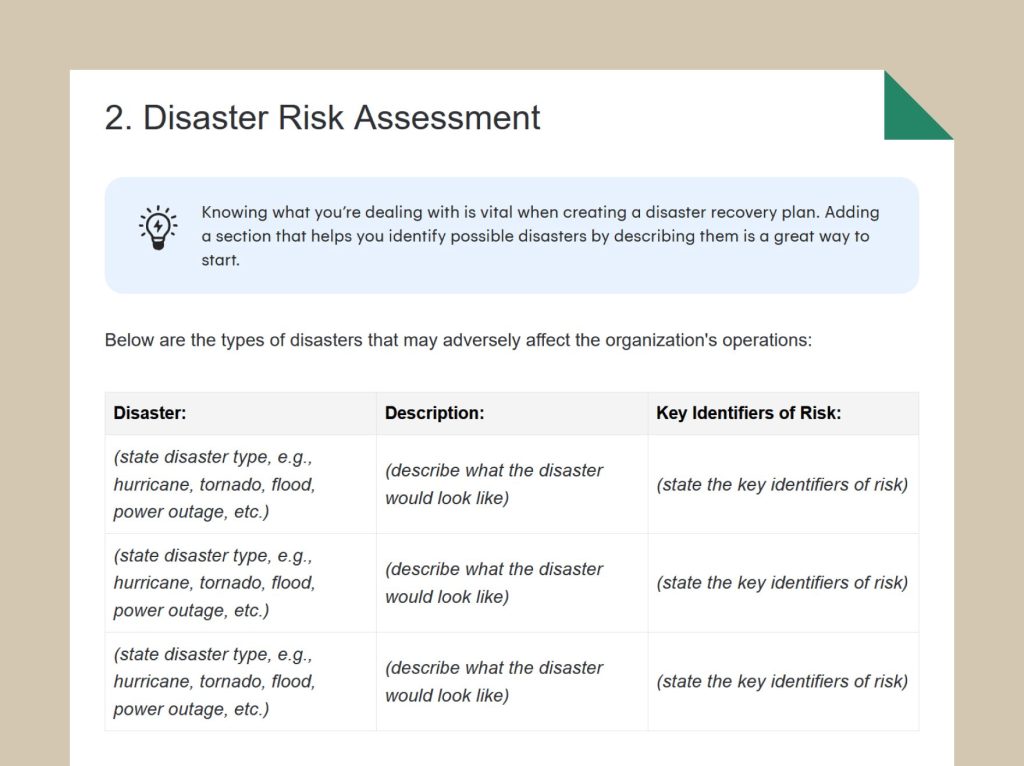
- Recovery team
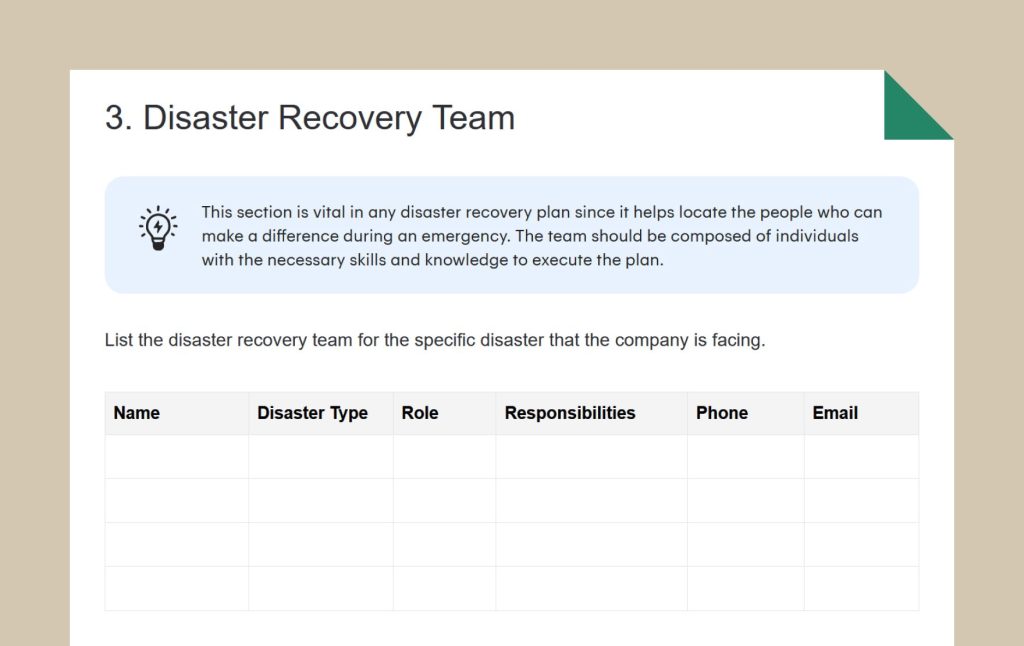
- Crisis communication plan
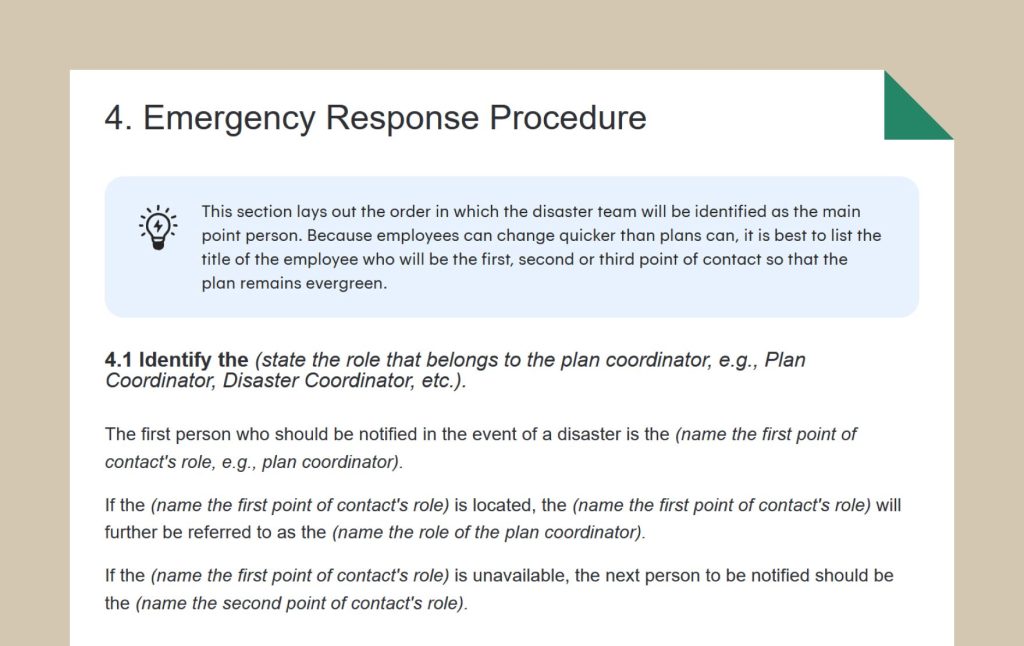
- Relocation and recovery operations
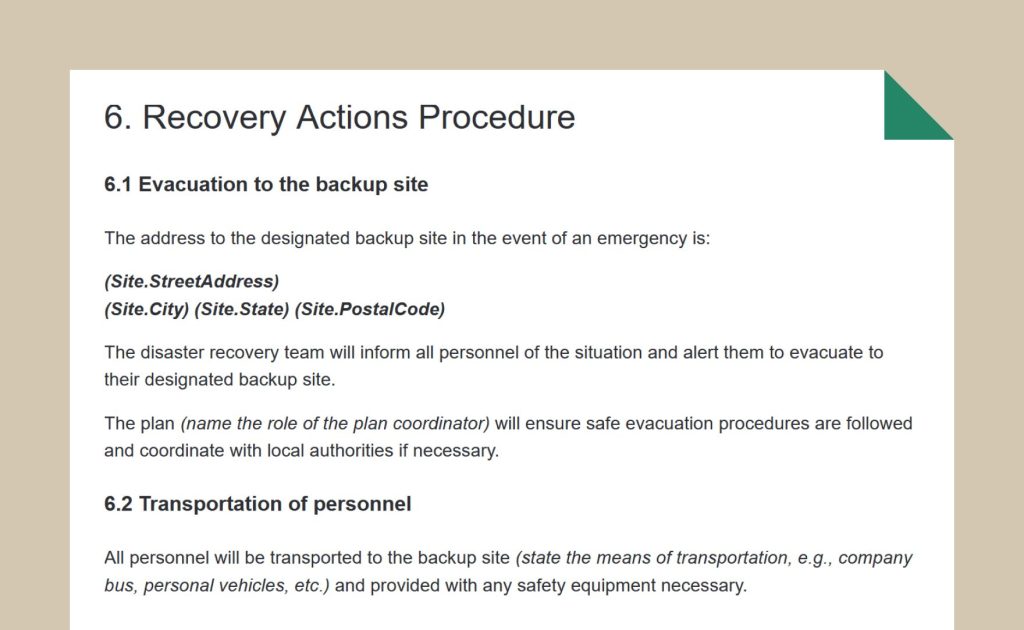
- Review and testing
(Sample text)
[Company Name] will set criteria for validating/testing the Continuity Plan, reviewing it every [time period] and conducting tests every [time period]. These tests will also serve as training for designated personnel. Testing methods include: [list the methods].
Pro tips:
- During or after a cyberattack, isolate affected servers by executing specific firewall rules (e.g., “iptables -A INPUT -s malicious_ip -j DROP”) and conduct a forensic analysis using tools like Volatility.
- Establish a communication protocol using encrypted channels (e.g., using the Signal app) for sensitive internal discussions.
- Utilize automated backup solutions like Bacula to streamline the recovery process.
- Leverage load balancing techniques for a seamless transition to backup servers, minimizing downtime and ensuring continuous service availability.
Step 7: Warriors are made, not born — put your BCP to the test and train your team
Without tests, you can’t know for sure how well your methods and continuity techniques will work.
You won’t reveal weaknesses and areas for improvement, either.
Gather your continuity team and engage in tabletop exercises that challenge their decision-making and response coordination.
Create detailed scenarios that mimic real-world disruptions like a cyberattack, natural disaster, or pandemic, and evaluate how the BCP performs under these conditions.
Perform gap analysis after each test to identify areas for improvement.
Regularly conduct security audits and penetration tests to find and rectify vulnerabilities before they can be exploited.
Cyberattacks are the worst enemy for any modern business without a BCP
Businesses without a BCP are exposed to cybersecurity threats, including data breaches, ransomware attacks, and system vulnerabilities.
These threats extend beyond financial implications, touching upon reputation damage, legal liabilities, and operational disturbances.
According to a Check Point Research survey, 50% more cyberattacks per week on corporate networks were reported in 2021 compared to 2020.
Another research reported ransomware damage expenses reached $20 billion back in 2021.
The cost is forecast to exceed a mind-blowing $265 billion in 2031.
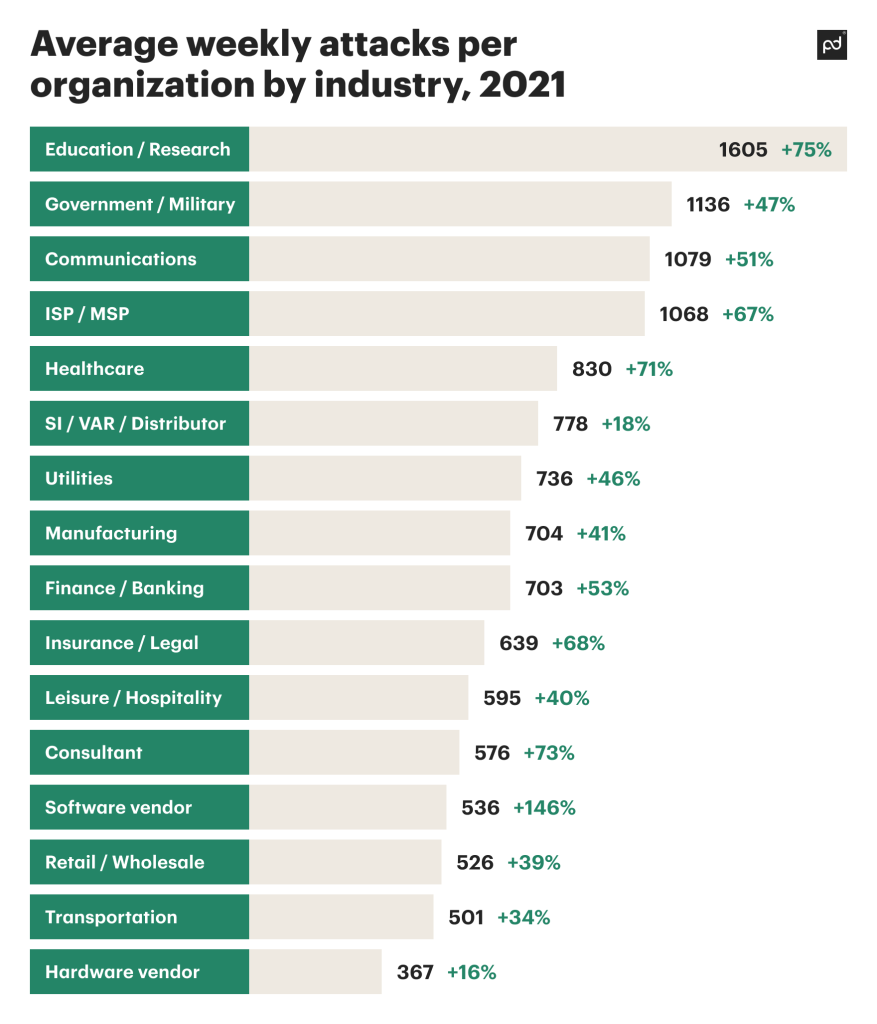
A recent incident forced a gigantic Chinese bank to drive their portfolio/trading info across town in a USB drive as their “BCP.”
This clearly sets cyberattacks as one of the most relevant threats businesses of all sizes face.
Business continuity plan vs. disaster recovery plan
What is the difference between a business continuity plan and a disaster recovery plan (DRP)?
There’s none because a disaster recovery plan is a subset of a BCP. The devil is in the details.
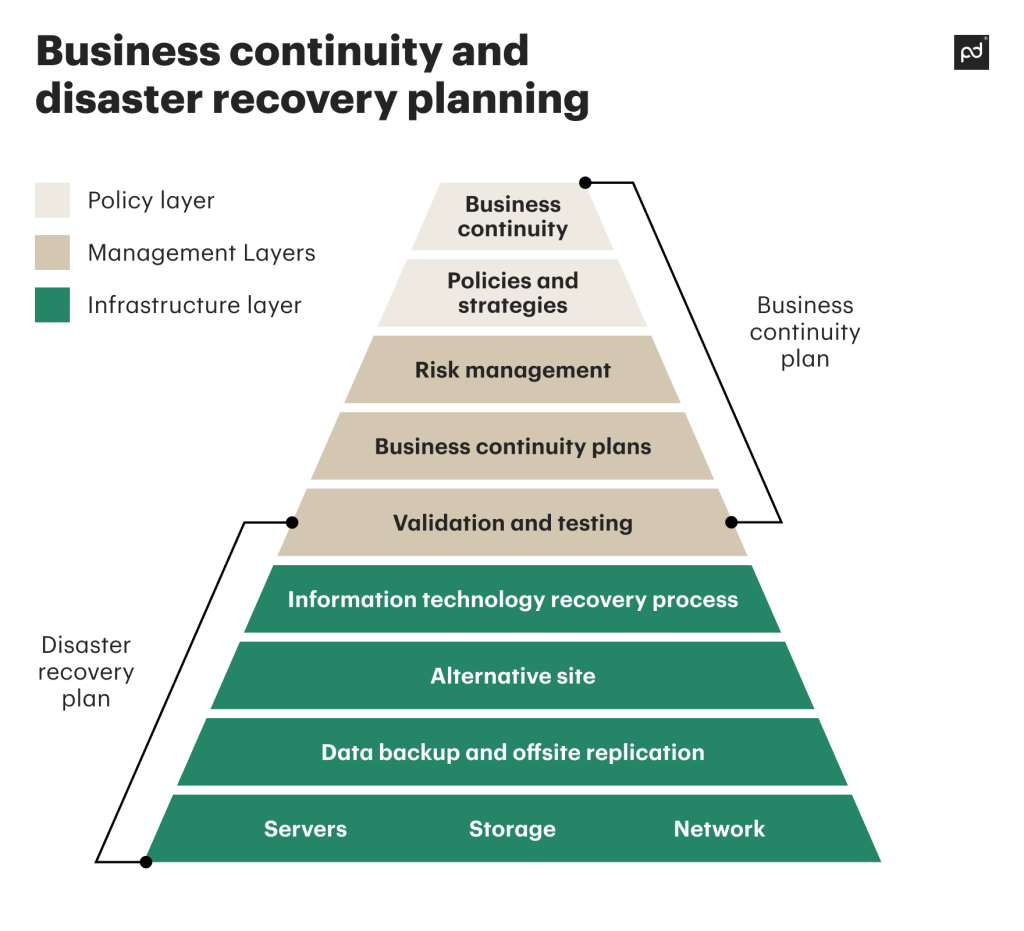
A business continuity plan is your organization’s central shield against disruptions.
It’s your all-encompassing strategy to reduce downtime, minimize damage, and maintain your organization’s overall health.
Meanwhile, a DRP zooms in on your information technology infrastructure and data. It’s your insurance policy for digital assets.
Disaster recovery plans provide precise procedures for data backup, recovery, and system restoration in case of data-related cataclysms.
Together, they form an unbeatable hybrid to make your organization resilient and ready to tackle any challenges that come your way.
Don’t navigate this journey alone
In a world where disruptions are the norm, your BCP is a guardian against the unexpected.
PandaDoc is your dedicated partner, ready to facilitate your document automation and provide business continuity plan templates.
We offer the tools and expertise to help you build a robust BCP. No matter the disruption, we’re here to bolster your preparedness.
If you need professional advice, please don’t hesitate to drop us a line anytime you see fit.
Disclaimer
PandaDoc is not a law firm, or a substitute for an attorney or law firm. This page is not intended to and does not provide legal advice. Should you have legal questions on the validity of e-signatures or digital signatures and the enforceability thereof, please consult with an attorney or law firm. Use of PandaDoc services are governed by our Terms of Use and Privacy Policy.


